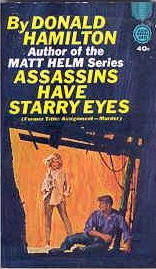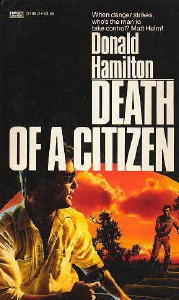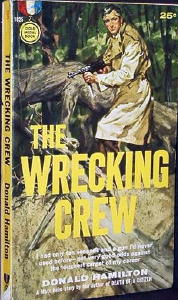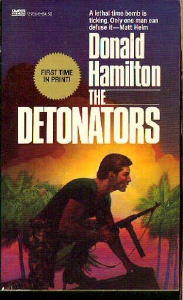THRILLER WRITERS #1: DONALD HAMILTON, by
John Fraser
Preamble:  Sharing pleasures can be fun. In How to Read (1928) Ezra Pound offered a list of essential classics to read if you wanted to get a fix on the art and craft of writing; wanted do a bit of self-educating; wanted to write better, wanted to enjoy yourself, free of the felt tyranny of the academy. (“Oh, but you simply have to read Spenser Milton Dryden Wordsworth Scott Thackeray Browning etcetera.”) It was considered idiosyncratic, but it was a pretty damn good list, and, like his elaboration of it in ABC of Reading (1934), liberative. Terry Teachout has been making some swell lists of twentieth-century composers and performers. So I may as well have a go myself with thrillers, having recently looked at so many long lists in reference books and surveys, and encountered so many judgments, explicit or implied, which I disagreed with, that my head has been feeling as if it had been packed with cotton. Who is my own list for? Well, for myself, certainly, to remind me of things that I have felt. And for at least a few of the sympathetic readers, if there are some, of my other pieces – readers who may not be thriller readers themselves, but who feel that they might want to do a bit of exploring. And for thriller readers whose tastes may partly overlap mine and who are interested in lists, if only to disagree with them. And, well, maybe the kinds of readers who don’t like what I say about thrillers, and whom it might be fun to annoy. Most of these jottings are ones that I made back in 1990 about works that had stayed in my head, one way or another, and given me pleasure, and that might or did still do so. I must emphasize “for pleasure.” As I explain in “Reading Thrillers,” I read thrillers for pleasure. I didn’t study them, nor was I concerned to fill in “gaps” or give this or that author “a fair chance.” I knew what I liked when I liked it, and what I didn’t like. What worked for me, you might say. Or didn’t work as well as I had hoped. What we have here is a configuration, a pattern, of taste. It’s mine, simply mine. But I like it better than some of the ones I have seen in conventionally published books. A number of the works that I mention haven’t had their due – in a few instances, scandalously so. Contrariwise, I’ve been glad to come upon a few admired recent ones that seem to me indeed very good. As Samuel Johnson said on one occasion, “I rejoice to concur with the common reader,” something he didn’t normally do a lot of. Terms like “enjoyment” and “pleasure” are notoriously slippery, of course. And inescapably personal. They can extend to works that fascinate, even horrify, like one or two on my list, but which, like the more benign ones, have a charge of felt life to them, a stylistic energy and/or craftsmanship. Works, that is to say, in which you are drawn forward by the feeling, the pleasurable feeling, that something fresh is happening, that it’s going on happening, that the promise of the opening has been sustained. The primal thrill of reading, reading of any kind. Well, any “literary” kind. As distinct from the secondary, but also real, pleasures of historical scholarship, of time-travelling back into the styles and mores of earlier periods and genres. There are lots of other thrillers that I’ve had that primal experience with, of course. But lots of thrillers, like a lot of movies, fade, so that, on revisiting them years later, you know what you’re supposed to be feeling but don’t feel it; which can be a depressing experience, unless you’re primarily interested in re-enacting your youth. If some well-known authors are missing, it is because they seem to me to be writing books about criminals, rather than thrillers, or books about detection in which there isn’t a sufficient urgency and risk, or because I simply haven’t liked them enough. But some novels of straight detection, such as Hillary Waugh’s ground-breaking police-procedural Last Seen Wearing (1952), are indeed gripping. Back in 1969, that marvellous jazz reviewer Phillip Larkin remarked, “If I were to frame Larkin’s Law of Reissues, it would say that anything you haven’t got already probably isn’t worth bothering about.” I can’t be that draconian, even tongue-in-cheek, but I tend to feel that if a thriller hasn’t been paperbacked, it probably won’t be my cup of tea. A lot of the books that I mention are ones that I first read as paperbacks.  Donald Hamilton:
Donald Hamilton: I had worked out the range from the
window to the yellow fire hydrant down at the intersection three blocks
away. It was four hundred and twenty-six yards on a scale map of the
city; four hundred and twenty-two by counting paces and calculating
angles. The difference wasn’t enough to worry about. I had a sandbag
rest for the gun just inside the window and a six-power telescopic
sight. The gun itself was a star-gauge Springfield they had picked up
for me; it would shoot better than inch groups at a hundred yards now
that I had tuned it and learned what ammunition it liked. Most people
don’t seem to know it, but guns are very particular about what you feed
them; what’ll shoot like a dream through one musket will spray all over
the landscape from another. This particular gas pipe liked the
hundred-and-eighty-grain of Hi Vel No.2 powder which pushed it along, I
figured, at better than twenty-eight hundred feet per second.
The opening lines of Line of Fire (1955). I Donald Hamilton is one of the three best American thriller writers, the other two being Dashiell Hammett and Ross Thomas. I talk about him at some length in “Writer at Work” and will try not to repeat myself here. I will mainly comment on the Helm books, the twenty-eight-volume series about counter-terrorist government agent Matt Helm that began in 1960 with Death of a Citizen and continued into the Nineties, interrupted only by The Mona Intercept (1980). First, though, a word about the books of the Fifties and post-war Forties. II If you were going to read only one novel by Hamilton, it would have to be the superb Line of Fire, its prose a steady delight in its lucid, tactile rendering of episode after shapely episode. You are there that Saturday morning in the empty downtown office with gunsmith Paul Nyquist and a minor hoodlum, awaiting the entry, at just over four hundred yards, of Governor Martin Maney; – there when Nyquist briefly takes it on the lam to a lakeside resort when things go dramatically wrong after he shoots; – there when he’s back in the city (Midwestern, by the feel of it, with lovely summer heat), coping with his friend Carl Gunderman, the crime boss who’d asked him to do the shooting, and the boss’s resentful right-hand man Brooks, and a cop or two, and a crusading reporter, and the young widow who – but read the book for yourself. You won’t be disappointed. And after that (OK, two books?) well, the best of his five excellent Westerns, Smoky Valley (1954), has a similar clarity, firmness of outline, physicality, and abundance of memorable scenes, and a similar ironical self-awareness on the part of its young hero, ex-Union Army Major John Parrish, out West to recuperate from a war wound, as he tries to maintain his self-defined way of life and avoid being drawn into moral crusading against the local predators – whom he handles with the same ruthless effectiveness as Nyquist when he finally does get drawn in. It contains some of Hamilton’s finest writing.  And after that (so let’s have a trio), how about my own other special favourite, The Steel Mirror (1948), the best of the three fascinating books from the post-war Forties in which Hamilton was at work, with considerable moral delicacy, on relationships between young men and women brought together in dangerous situations that really test their characters. It’s a moving narrative of the growth of love. It’s also lovely with the romance of long-distance driving across a continent that still was romantic, in the way that the America of Edward Hopper’s magnificent paintings was romantic – a romance that emerges from things, when rightly examined, rather than being simply draped over them. This is an America, from Illinois down into Colorado, traversed with caring eyes, before the freeways and the Howard Johnsons and USA Today. Where an angry small-town sheriff in Illinois could be as scary as one down South. With a dash of espionage, and a layer of unresolved Occupied France guilt and accusation, and one of the sexiest bits of nudity in any thriller. III Oh, and don’t miss Assignment: Murder (1956; a.k.a. Assassins Have Starry Eyes), with its atomic physicists who actually feel like scientists, a lovingly evoked New Mexico, a marriage between two difficult individuals that oughtn’t to work and yet hearteningly does, and the toughest-minded hero-narrator, Jim Gregory, in all of Hamilton’s novels, not excepting the Helms. When I say “tough-minded” here, I have in mind William James’ well-known distinction between the tough- and the tender-minded. Hamilton himself is a tough-minded writer, not a hardboiled one. There’s a difference. A hardboiled writer, Peter Rabe for example, can be more predictable and less challenging, because less intellectually demanding. IV  The Helm books weren’t the first important American series about a government secret agent. So far as I know, Edward S. Aarons started things off with Sam Durrell in Assignment to Disaster (1955), three years after the first James Bond, Casino Royale. But the Helm series, uneven though it is, is far and away the best, in a genre that American writers, in contrast to British ones, mostly haven’t been at home in or handled well. Years ago, W.H. Auden suggested that the English were natural-born spies. I suspect that for a lot of Americans, spying and secret agenting, with their chronic duplicity, have seemed sort of, well, sneaky and unsociable (“My son the spy”?) and should be left to Boris Badenov and Spy vs Spy. Spying is what is done to America by others. The sympathies of American novelists and movie-makers have largely been reserved for individuals who become innocently and unpleasantly involved with the CIA or some even tackier organization, or are trying to resign from one, as in Richard Condon’s Three Days of the Condor. What other American series were there in the Sixties, apart from the Durrell books, to set beside those of Britishers like Ian Fleming, Len Deighton, Simon Harvester, Adam Hall, Brian Cleeve, Andrew York, William Garner, James Mitchell, and others? The names of Philip Atlee, E. Howard Hunt, William F. Buckley, Jr., and Mickey Spillane (in his Tiger Mann books) aren’t exactly a constellation lighting up the night sky. V A Helm short-list? Not easy. I haven’t reread all of them, and there’s plenty of disagreement among aficionados. But Death of a Citizen (1960), The Wrecking Crew (1960), The Removers (1961), The Ambushers (1963), The Interlopers (1969), The Intriguers (1972), The Intimidators (1974), The Revengers (1982), and, for its first two-thirds or so, The Detonators (1985), are all strong. Not a very short list, I’m afraid.  If I had to chose a single
Helm to set beside the earlier titles that I picked, I guess it would
have to be Death of a Citizen,
written, by Hamilton’s own account, before he knew that there was going
to be a series. Matthew Helm, Santa Fé writer and
photographer, and former wartime operative, is morally still a free
agent (no word-play intended), not someone carrying out, however
flexibly, the directives of superiors. If I had to chose a single
Helm to set beside the earlier titles that I picked, I guess it would
have to be Death of a Citizen,
written, by Hamilton’s own account, before he knew that there was going
to be a series. Matthew Helm, Santa Fé writer and
photographer, and former wartime operative, is morally still a free
agent (no word-play intended), not someone carrying out, however
flexibly, the directives of superiors.In the later Seventies, Hamilton took time out to do The Mona Intercept (1980) and probably rethink the Helms after the unusually savage The Terrorizers (1977), precursor to John D. MacDonald’s The Green Ripper two years later. The Mona Intercept is a valiant try at a multiperspectival, fat-best-seller, airport-newsstand thriller, a splendid read in parts, less than convincing in others, though never dull; a thinking person’s precursor to Frederick Forsyth’s big-ship thriller, The Devil’s Alternative (1982). After which Hamilton returned to Helm in 1981 with renewed vigour and at greater length, and kept going for thirteen more years. Self-correction is among his strengths as a writer. Several times a weak Helm has been followed by a strong one. VI The Helm saga is at its most consistent in the eight books which appeared in a sustained burst of energy between 1960 and 1965. Helm and Hamilton are still figuring out what is entailed in living by a ruthless, task-oriented professional code while hungering for satisfying non-professional sexual relationships and trying to remain, up to a point, a reasonably decent and civilized human being. Which Helm indeed, up to a point, is. He was a genuinely peaceable and loving husband and father during his marriage to gentle Beth before the savage past re-entered his life in Death of a Citizen. And if you were to meet him later on at a party, you would have no trouble taking him as the free-lance writer and photographer that in fact he continues to be as one of his covers.  What has really bothered some people about the books, I suspect, is not that Helm himself doesn’t wear horns (though there’s a nice bit of by-play in one of them about his “humorously Satanic” look), but that neither do most of the enemy agents whom he kills in the line of duty, sometimes after quite cordial exchanges. If he’d simply been ridding the world of strutting fascists and wicked multimillionaires, there wouldn’t be a problem. Subsequently (partly perhaps from contamination from the four Dean Martin movies), the plots became more theatrical, with increased numbers of sexy women, a sinister underground laboratory in Scotland, sneaky Madame Ling and Mr. Soo, an evil Canadian (Canadian?) clinic in which Helm is tortured by an acromegalic woman doctor, a group of rich right-wingers who want to steal Baja California away from Mexico, and so on. VII It’s all great fun, and of course there are touches of humour throughout the series, particularly in Helm’s quasi-filial relationship with Mac, his cool, grey-haired Washington boss, with his dark-grey suits, his coal-black eyebrows, and his fondness for linguistic precision. (The plot of The Intriguers partly hinges on someone’s use of the word “contact.”) But there’s a slackening of intensity, and when Helm starts being complimentary about the foreign parts his missions take him to, instead of being mildly irritated by their foreign ways, you feel that the author, who obviously traveled himself in search of locations, may be courteously saying thanks for a pleasant stay. In Death of a Citizen the famous Menger Hotel beside the Alamo in San Antonio wasn’t even given a name. It was simply a hotel lobby and a bedroom where things happened. It might as well have been a Howard Johnson. At times, too, we and Helm have to sit and listen while some character provides, in unnaturally tidy prose, plot information that hasn’t been sufficiently incorporated into the action. When it comes to plotting, particularly plotting by the bad guys, Hamilton doesn’t achieve the Swiss-clock precision of Ross Thomas. But then, who does?. Still I can’t help wondering why no Mafia smuggler had noticed those extra-heavy cans of dope in The Removers. Nor is Hamilton’s ear for women’s speech in the Helms and The Mona Intercept, especially that of younger ones, always what it might be. VIII But Helm’s depictions of his non-violent outdoor activities are always convincing – fishing, sailing, surfing, driving a half-ton truck over rough terrain, crash-landing a small plane, and so forth. And almost every book contains stretches of lovely clear firm “action” narrative, often at the beginning and end. Hamilton has also put a lot of thought into Mac’s anonymous Washington-based government organization, with its WWII origins, intelligent operational rules, and hideaway “ranch” in the Southwest for recuperation, psychological monitoring, and post-trauma surgery when necessary. (Helm’s body must carry a lot of interesting scars.) Unlike Quiller, Helm has mission dealings (often less than entirely amicable) with plenty of fellow operatives, both male and female, with various degrees of expertise. Hamilton continues, too, the interplay of stereotypes (largely derived from books and movies) and actualities that he had been engaged in in the Forties works, where Humphrey Bogart epitomized masculine toughness. Helm has been to the movies and watched TV. He knows the clichés. He knows how he’s “supposed” to be behaving as a secret agent at times (and isn’t) – and how at times he’s indeed being Secret Agent Helm, sexual satyr. At bottom, though, what interests him most, professionally, is the complicated mind-games that adversaries play with one another, the successful gambling of his life, from time to time, on non-reckless guesses about how other will behave, and the obligation to defend, to the unsympathetic, the continuing social necessity for persons like himself.  IX What we have in these books, in effect, is a war ethos in a peacetime setting. It departs in various ways from the rules of civilized warfare, in which adversaries can withdraw from combat by surrendering or being physically incapacitated, and are then treated differently from combatants. In Helm’s kind of war, there is no romantic chivalrousness. If you have to kill someone, it doesn’t matter what you do it with or whether from the front or the back. At the same time, though, one of his deepest values is the distinction between “peace” and “war” when people other than adversarial pros are face to face. As long as someone behaves civilly Helm will treat them civilly in return – physically, at least. But the moment they open the door to violence, if only by producing a gun for purposes of intimidation, they cannot complain if the most vigorous counter-violence is used against them, regardless of their gender. A peace-loving amateur with a little itty-bitty .22 that of course they don’t mean to use (but who’s to know?) can kill you just as dead as a seasoned pro with a Luger that he or she obviously has no reason to use at that point. With pros, you are in fact less likely to have violence, most of the time, than with amateurs. Amateurs – or more accurately the amateurish – are playing with imperfect skills and insufficient commitment in games whose rules they don’t fully understand. X But if romantic sentimentality can be a handicap, at times a lethal one, so can machismo, revenge-seeking, and crusading. Helm goes on coping with them in others, resisting the occasional temptations in himself, and getting along in a civilized way, up to a point, with adversaries, especially female ones. In other words, avoiding being locked into long-term roles that preclude an enjoyment of present moments. And a lot of interesting variations get played in the series on the kinds of sexual relationships in which both parties can achieve a reasonable degree of emotional sincerity even when each knows or suspects that the other has a contrary scenario. Nor does Helm (who’s no superhero and makes plenty of mistakes) always act as tough as he talks or abide by his own and his organization’s ruthlessly goal-oriented principles. In the longer post-Mona Intercept books, which I don’t think have had their due, there are interesting softenings of the edges of his personality, though even before them it often turns out that some seemingly callous bit of behaviour had a humane motive behind it. With more pages in the later books to turn around in, Matt can make more allowance for the weaknesses of some of his now more fully modeled, and mostly younger, fellow operatives, as well as experience real grief himself at the loss of a couple of beloved woman.  In The Detonators (1985), after its almost uniformly strong and clear first two-thirds, and one of the most vivid scenes of effective violence in the whole series, he comes attractively close to giving way to the sentimentality that an even tougher-minded pro attributes to him in an amusing scene of horn-locking under the sardonic gaze of Mac. XI Like Travis McGee, but more complexly, Helm is a voice, an ongoing voicing across three decades, commenting on things as they come up, new places, new experiences, new manners and morals (particularly sexual ones), expressing preferences and prejudices freely, but not locked into them, and pleasantly surprised when something proves to be better than expected – a self-aware, self-critical, and, yes, civilized voice, with a variety of registers in it that are in fact more true to how we actually organize perception than the monotone of formal “realism.” Personally I think the voice is best in the early Sixties books, when it tends to be in the irritation mode, and also later on in Helm’s explicitly maturer incarnation in the post-Mona books. Like McGee (but more affirmatively) and unlike Quiller, Helm has gone on evolving. If he didn’t, he and his creator wouldn’t have mattered so much to so many intelligent readers. Let us hope that his publishers will now, post-9/11, and with the fin-de-siècle Nineties behind us, relent and let us have the final volume in the Helm saga. © 2002 by John Fraser. For more of John Fraser’s on-line commentary on thrillers and thriller writers, go to http://www.jottings.ca/ john/thriller_main.html. NOTE: Following the appearance of this article, Doug Bassett submitted a follow-up piece in which he does an in-depth comparison of Matt Helm with Travis McGee, John D. MacDonald’s long-running series character. _____________________________________ YOUR COMMENTS ARE WELCOME:
Return to
the Main Page.
|